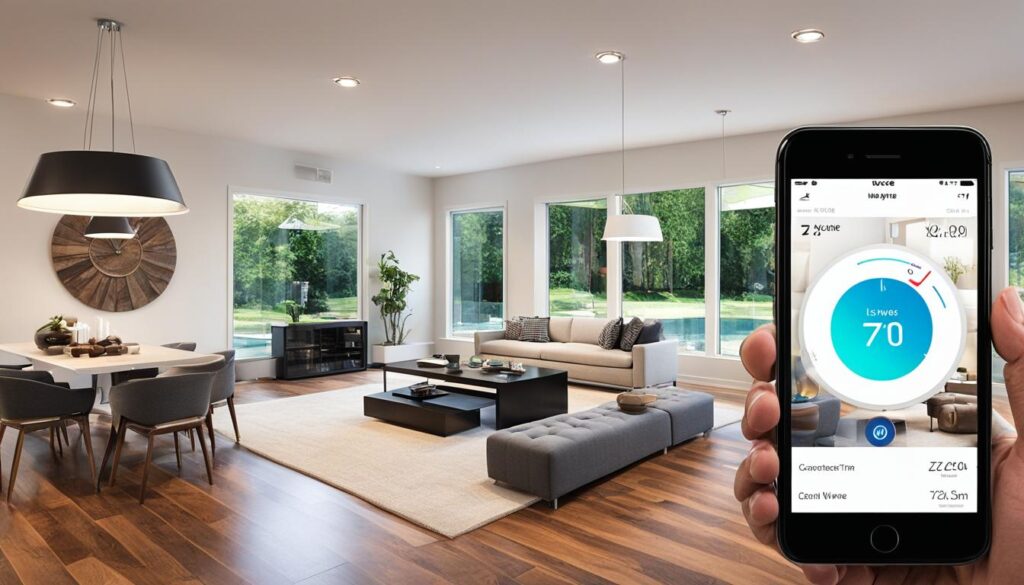If you’ve ever dreamed of living in a smart home where your devices seamlessly communicate with each other, then you’re in the right place. Welcome to the beginner’s guide to Z-Wave and home automation. In this guide, we will demystify Z-Wave, a wireless communication technology that brings your smart home setup to life.
Imagine being able to control your lights, thermostat, security system, and more, all from the convenience of your smartphone or through voice commands. With Z-Wave, this level of seamless automation and control is within reach.
Whether you’re a tech enthusiast or just starting your smart home journey, understanding Z-Wave is essential. In this guide, I will walk you through what Z-Wave is, how it works, its benefits and features, setting it up in your smart home, and even how it can be integrated with other home automation protocols.
Table of Contents
Key Takeaways:
- Z-Wave is a wireless communication technology designed for home automation.
- It allows devices and systems in a smart home to connect and communicate with each other.
- Z-Wave operates on low-power radio waves, enabling energy-efficient communication.
- The mesh network topology of Z-Wave ensures reliable and robust communication between devices.
- Z-Wave offers interoperability, scalability, and robust security measures for your smart home.
What is Z-Wave?
Z-Wave is a wireless communication technology that enables devices and systems in a smart home to communicate with each other. Utilizing low-power radio waves, Z-Wave facilitates reliable and energy-efficient communication throughout your smart home ecosystem.
With Z-Wave, you can seamlessly integrate a wide range of devices, from smart lights and thermostats to door locks and security systems. This interoperability allows for a comprehensive and interconnected smart home setup, where your devices work together harmoniously to enhance comfort, convenience, and security.
By utilizing Z-Wave wireless communication technology, you can control and customize your smart home from a centralized hub or smartphone app. Whether you’re adjusting the lighting, regulating temperature levels, or monitoring your home’s security, Z-Wave provides a robust foundation for building a truly smart home system.
“Z-Wave enables seamless communication between devices and systems in your smart home, allowing for enhanced control, convenience, and automation.”
How Does Z-Wave Work?
Z-Wave operates on a mesh network topology, where devices known as nodes communicate with each other to send and receive commands and signals. This intelligent network architecture ensures reliable and efficient communication within your smart home ecosystem.
Each Z-Wave device functions as a signal repeater, enhancing the strength and range of the network. This means that even if a device is far apart or obstructed by walls or other objects, it can still connect and communicate seamlessly with other devices.
“Z-Wave’s mesh network creates a robust and resilient communication infrastructure, eliminating dead spots and ensuring that commands and signals are reliably transmitted throughout the network.”
This mesh network provides the following advantages:
- Redundancy: Each device has multiple paths to communicate with other devices, reducing the risk of signal loss or interruption.
- Extended Range: The network coverage expands as more devices are added, allowing you to control devices in different rooms or even outside your home.
- Self-Healing: If one node becomes unavailable, the network automatically finds an alternative path for communication, ensuring continuous responsiveness.
The diagram below illustrates the concept of a Z-Wave mesh network:
| Z-Wave Mesh Network |
|---|
 |
As depicted in the diagram, each device acts as a node, interconnected through the mesh network. This interconnectedness enables devices to work together harmoniously, creating a seamless and intelligent smart home experience.
Now that we understand how Z-Wave works, let’s explore the benefits and features it offers in the next section.
Z-Wave Benefits and Features
When it comes to home automation, Z-Wave offers numerous benefits and features that make it a top choice for smart homeowners. Let’s dive into the advantages that set Z-Wave apart from other wireless communication technologies.
Interoperability for Seamless Compatibility
Z-Wave stands out for its interoperability, allowing devices from different manufacturers to work together seamlessly. This means you have the freedom to choose products from various brands without worrying about compatibility issues. Whether it’s smart lights, thermostats, or security systems, Z-Wave devices can effortlessly integrate and communicate with each other, creating a cohesive and interconnected smart home ecosystem.
Scalability for Convenient Expansion
Another key advantage of Z-Wave is its scalability. As your needs and preferences evolve, you can easily expand and customize your smart home system with Z-Wave devices. Whether you want to add more sensors, switches, or controllers, Z-Wave allows for hassle-free integration and growth. This flexibility ensures that your smart home can adapt to your changing lifestyle without the need for a complete overhaul.
Robust Security Measures for Peace of Mind
Security is a top priority when it comes to home automation, and Z-Wave delivers. With built-in security features, Z-Wave offers protection against unauthorized access to your smart home network. It utilizes encryption protocols to safeguard your data and ensure privacy. This means you can have peace of mind knowing that your smart home is secure and your personal information is well-protected.
“Z-Wave’s interoperability, scalability, and security make it an ideal choice for homeowners looking to build a smart and secure home.”
Overall, Z-Wave’s benefits and features make it a standout option for home automation. Its interoperability allows for effortless compatibility between devices, its scalability lets you easily expand your smart home system, and its robust security measures offer peace of mind. With Z-Wave, you can create a smart home that caters to your needs while enjoying the convenience and efficiency that automation brings.
Setting Up Z-Wave in Your Smart Home
To set up Z-Wave in your smart home, you will need a Z-Wave controller or hub. This device serves as the central command center for your Z-Wave network.
When setting up Z-Wave, you’ll need to include new devices into the network through an “inclusion” process. The inclusion process allows the Z-Wave controller to add the new device to the network, establishing communication and integration. This step is essential for ensuring that all your Z-Wave devices can work harmoniously within your smart home ecosystem.
On the other hand, if you need to remove a device from the network, you’ll perform an “exclusion” process. The exclusion process removes the device from the Z-Wave network, effectively severing its connection to the controller.
Once you have included the desired Z-Wave devices in your network, you can use the Z-Wave controller to customize and manage their settings. This allows you to personalize the behavior and functionality of each device according to your preferences and needs.
Below is a simplified step-by-step guide on setting up Z-Wave in your smart home:
- Acquire a Z-Wave controller or hub.
- Put the controller or hub in inclusion mode.
- Activate the inclusion or pairing mode on the Z-Wave device you want to add.
- Wait for the controller or hub to recognize and include the device into the Z-Wave network.
- Repeat the process for each Z-Wave device you wish to add.
- Use the Z-Wave controller to customize and manage the settings of your devices.
By following these steps, you can easily set up and configure Z-Wave devices in your smart home, creating a sophisticated and interconnected automation system.
| Step | Description |
| — | — |
| 1 | Acquire a Z-Wave controller or hub. |
| 2 | Put the controller or hub in inclusion mode. |
| 3 | Activate the inclusion or pairing mode on the Z-Wave device you want to add. |
| 4 | Wait for the controller or hub to recognize and include the device into the Z-Wave network. |
| 5 | Repeat the process for each Z-Wave device you wish to add. |
| 6 | Use the Z-Wave controller to customize and manage the settings of your devices. |
Z-Wave Integration with Other Home Automation Protocols
Z-Wave can be seamlessly integrated with various other home automation protocols, expanding the capabilities of your smart home system and creating a unified experience. By integrating Z-Wave with these protocols, you can unlock a wider range of compatible devices and enhance the functionality of your smart home.
One popular integration option is with Zigbee, another wireless communication protocol widely used in home automation. Zigbee-compatible devices can be easily integrated with your existing Z-Wave network, allowing you to expand the range of available smart home products. This integration enables you to choose from a larger selection of devices that can be seamlessly added to your smart home ecosystem.
Additionally, Z-Wave devices can be connected to Wi-Fi networks, allowing for remote access and control. This integration enables you to control your Z-Wave devices remotely, even when you are away from home. Whether you want to adjust the temperature, turn on/off lights, or monitor security cameras, you can do so conveniently and securely using your smartphone or tablet.
Furthermore, voice assistants like Amazon Alexa and Google Assistant often support Z-Wave, providing you with a hands-free control experience. By integrating Z-Wave with these popular voice assistants, you can control your smart home devices using simple voice commands. For example, you can say, “Alexa, turn off the lights” or “Hey Google, set the thermostat to 72 degrees.” This integration adds a new level of convenience and automation to your smart home.
Overall, by integrating Z-Wave with other home automation protocols such as Zigbee, Wi-Fi, and voice assistants, you can create a comprehensive and interconnected smart home ecosystem that brings together the best features and functionalities. This integration expands your options for devices, enhances remote accessibility, and enables convenient voice control, making your smart home experience even more seamless and enjoyable.

Conclusion
In conclusion, Z-Wave is an essential technology for anyone looking to dive into the world of home automation. By incorporating Z-Wave into your smart home setup, you can achieve seamless automation and control over various devices and systems, creating a truly interconnected and efficient home.
This beginner’s guide has provided a comprehensive overview of Z-Wave, its benefits, features, setup process, and integration options. With this knowledge, you can confidently embark on your journey to create a smart and connected home that meets your unique needs and preferences.
Whether you’re a beginner or a seasoned enthusiast, Z-Wave offers the flexibility, scalability, and security necessary to build a robust smart home ecosystem. With its interoperability and compatibility with other protocols, such as Zigbee and Wi-Fi, you can enhance your smart home capabilities even further.
Don’t wait any longer, start exploring the possibilities of Z-Wave and experience the convenience and control it brings to your daily life. Transform your house into a truly smart home with Z-Wave and enjoy the endless possibilities of home automation.
FAQ
What is Z-Wave?
Z-Wave is a wireless communication technology designed for home automation. It enables devices and systems in a smart home to communicate with each other using low-power radio waves.
How does Z-Wave work?
Z-Wave works through a mesh network topology, where devices called “nodes” communicate with each other to send and receive commands and signals. Each Z-Wave device acts as a signal repeater, creating a robust and reliable network with increased range and coverage.
What are the benefits and features of Z-Wave?
Z-Wave offers interoperability between devices from different manufacturers, allowing you to choose products from various brands while ensuring compatibility. It is highly scalable, enabling you to easily expand your smart home system. Z-Wave also incorporates robust security measures to protect your smart home from unauthorized access and ensure data privacy.
How do I set up Z-Wave in my smart home?
To set up Z-Wave, you will need a Z-Wave controller or hub, which serves as the central command center for your Z-Wave network. You can include new Z-Wave devices by performing an “inclusion” process, where the controller adds the device to the network. To remove a device from the network, you can perform an “exclusion” process. Once your Z-Wave devices are included, you can customize and manage their settings using the controller.
Can Z-Wave be integrated with other home automation protocols?
Yes, Z-Wave can be integrated with other home automation protocols to create a versatile smart home ecosystem. It is compatible with Zigbee devices, which expands the range of available smart home products. Z-Wave devices can also be connected to Wi-Fi networks for remote access and control. Popular voice assistants like Amazon Alexa and Google Assistant often support Z-Wave, allowing you to control your smart home using voice commands.


